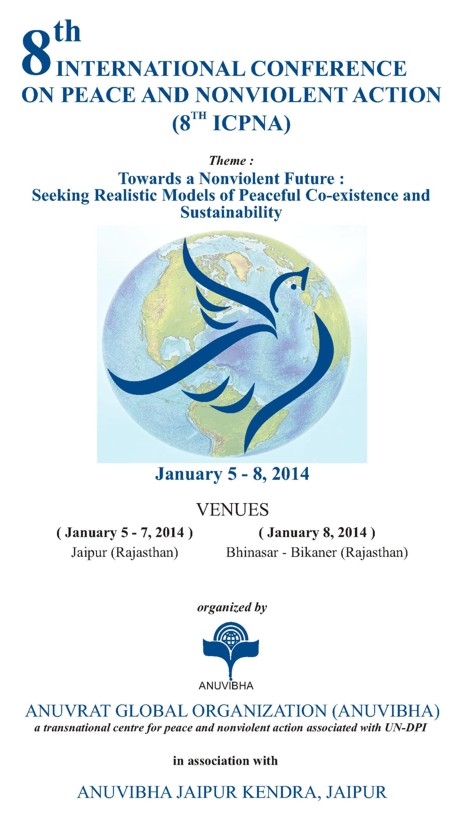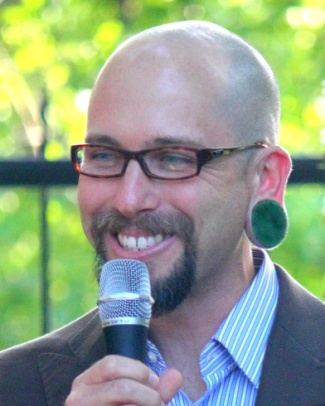 | 8th International Conference on Peace and Nonviolent Action |
Introduction
Imagine a desert valley. It looks something like Rajasthan brush, sand, scarce trees, veins of green along the single rivers and springs that come up in the midst of a harsh climate. On the dirt road that leads off the paved highway, one passes acres of an organic carrot farm. The water that is sprayed into the air through the sprinkler system is pulled from aquifers deep beneath the ground - water source from at least 10,000 year-old rainfall.
In the valley beyond the farm is an organization dedicated to modeling a regenerative way of living. They operate a youth and young adult program each year for three weeks entitled “Sustainable Vocations” - a program designed to train young leaders in sustainable practices and design. They focus on the “vocation” side of things - vocation coming from the Latin root “vocare” or “to call” - meaning not just a job or a career but that which you are called to. Participants come from all over - Mexico, California, West Africa - to participate in a program that ultimately awards them an internationally recognized certificate in sustainable design.
However, despite the nonviolent environments, programs, curriculum or camps we create, we do not immediately create “nonviolent” people: as the camp wore on, two weeks into the program, a situation of harassment took place between three of the young men and one young woman. While the situation was not dangerous, it was certainly violent - violent in the sense of violating a person’s freedom to be their self particularly based on their gender, to belong to and actualize their own unique gifts in a place that appreciates them.
In response to the situation, the leadership team called all the 19 youth participants together for a morning “council” circle. The way of council is a way of our indigenous and native peoples from all over the world - the premise is profound and yet simple - that in a circle, everyone is equal, everyone has the chance to speak openly and everyone has the responsibility to listen deeply. A sacred item is passed around, signifying who is currently the focus of attention and that individual takes as long as they need to speak their truth to the center of the circle. Then the item is passed on. The circle continues, on and on - if one person speaks then the item must be passed around again until the item winds its way around the circle without a single person speaking.
In response to the violence of harassment in the community, the circle was invited to share what it meant to have and to break trust. Vulnerable stories were told. Stories of suicide attempts. Stories of divorce. Stories of theft, broken hearts, absent parents, rape, diabetes, prostitution. Round and round the stories came out. As each young person shared a story, a new story emerged from across the circle. Six hours later, the circle went silent, gratitude was offered and the afternoon schedule was cleared for reflection, walking, meditation and listening to bird song in the valley.
At the end of the three weeks, when youth were asked to reflect on their favorite thing for the entire program - to select from all the adventures, design projects, amazing presentations, world-class guest speakers or social activities - nearly all of them said it was that Trust Circle that impacted them the most.
The teachers did not come to “teach” nonviolent communication, trust or the way of council. This was never part of the curriculum or the program. This was not a learning goal or academic standard - not on the brochure or on the website, nor did they promise this in a grant or to a donor. This is what emerged in spontaneous and natural interactions of young people who were living in a community that modeled the possibility of repairing the wounds of a culture that loves to separate, to waste and to dispose. In this environment, young people were held in a space where
- they were reminded of their connection to each other and to the natural world,
- they were in a place intentionally designed for aliveness and
- everyone else, especially the adults, was doing it.
This is the cultural repair movement.
I come to this conference as someone raised in the United States. I studied in India for my undergraduate degree at the Central University of Hyderabad, and I have since visited India ten times in the development of a transnational non-profit dedicated to cultivating young leaders who feel and live with aliveness. I share my lessons with you today, however, as someone from a predominantly western experience - and, in a way, a canary in a coalmine. The West has demonstrated the painful potential of capitalist consumer culture run amuck. The words “developed” and “developing” and “underdeveloped” never were nonviolent images for the future of our world - they are inherently violent, assuming a trajectory that follows the belief that there is only one “true” path to productive countries - a belief far from the principle of anekantevad of Jainism. These words and paradigms must be retired from our vocabulary because they are misnomers: “development,” if it follows the Western model, will surely be our global demise.
Culture Repair Principle 1: In-Tact Culture is Ecological
So what is cultural repair?
Primarily, “repair” implies a relationship has been wounded and requires mending. One of the primary beliefs inherent in the culture repair model is the belief that the primary fragmentation is the separation of ecological culture and social culture. Culture is and was always ecological - our primary identities are ecological identities - we are literally made of the food, water, air and earth around us. In the words of Indian food activist and physicist Vandana Shiva, “Ecological security is our most basic security; it is our most fundamental identity“. The difference between us and our ancestors, especially in a Western context, is that they knew this in their lives and lifestyles and we’re having to re-learn and re-member it.
Jon Young is a teacher, animal tracker and leader in this movement in the USA and one of the primary leaders in articulating its values and principles. In his own work as an anthropologist mentored by elders in the Native American tradition in the United States, Jon surveyed cultures from East Africa, indigenous Native North America and aboriginal communities in Australia. These cultures shared common features that he believed would be the key to repairing the fragmented cultures we live in - particularly in Western capitalist societies. These common features became the basis of what he calls the way cultural repair is taught to future generations through “coyote teaching.”
Jon Young noticed that all these cultures had several ways of teaching culture that regenerated itself - not just sustained a status quo, but kept communities alive. Also, these weren’t just “cultures” - these were what one might describe as “in-tact culture.” An in-tact culture is one that knows the source of those resources that sustain them and reveres that source. These are peace-making traditions that are inherently ecological and teach their children to be so in a way radically different than most of our nonviolent teaching, conferencing or programming today - a reality I will describe later.
What unites these cultures thought is an inherent awareness that all culture is ecological - the illusion is our separateness. The difference between our cultures today and the cultures experienced by our ancestors is the difference between an in-tact culture and a fragmented culture - our ancestors know where their livelihood came from (the earth and its creaturely life) and they revered the source. They also knew where their lives would end - the practice of tracking and bird language are excellent examples of this. An indigenous community with real predators - say a lion or a neighboring tribe - became very good at radical awareness and connection to their surroundings. The best informants of danger nearby were the cues and alarms from other animals, particularly birds. Birds were the original home alarm system.
This awareness is built into our DNA - it is not something we have to artificially teach ourselves, instead, it is something we must re-member. To invite our young people into nonviolent living demands that we reclaim and remember this knowing.
Cultural Repair Principle 2: In-tact Culture is Regenerative.
An in-tact culture, designed from its inherent ecological identity, is one that is not just sustained - but one that generates morelife. This is regenerative, not just sustainable. When we model our lives from principles of ecological design and live in reverence from that which sustains us, we design for aliveness - not for scarcity.
I would like to push against a quote that was said during the first day of our conference - that “the future of the world relies on our self-restraint and our non-killing.” I do not entirely agree. The future of our world, if we are to restrain ourselves, relies on our commitment to the creation of more life, more connection, more relationships, more joy, more abundance - not just renunciation, but celebration of that which sustains us. For people to choose to non-harm, they must choose to fall in love with the life force that is present in the creaturely world around them.
Designing to create more life as modeled from ecological principles is good economics, good education, and good quality of life. Two examples:
A great question to ask ourselves when we design anything - a classroom, an experience, an organization, a conference, a family - is this: would a natural ecosystem looks this way? Our obsession with outcomes, standards, straight lines, 90 degree angles and business-as-usual costs us aliveness and is only modeled on militaristic and capitalistic models of efficiency.Ahimsa at its best is not just non-harming, it is a thoughtful and intentional approach that seeks to maximize livelihood, relationships and connection.
Cultural Repair Principles 3: In-tact Culture is Mentored.
Curriculums, conferences, programs and work books do not teach non-violence. These business-as-usual pedagogies that isolate people from the experiences of their ecological and social cultures do not effectively impart values of peace, connection, earth-connection or deep awareness. Ultimately - culture, in-tact culture, is learned when it is mentored to us by the people around us. Culture is learned because everyone is doing it, not because everyone is saying it.
As a youth worker and minister, I quickly realized that my curriculums and programs were just excuses for young people to come together to learn about what it meant to be fully alive and fully human. Although my curriculum engaged youth in actualizing their whole selves through dialogue and social justice work, youth learned more from watching me live my life as an activist than what I said about what it meant to be an activist, to be a feminist, or to be an ecological being on this planet. While we talked about the importance of communication and connection in creating peaceful communities, youth would notice far more if I was distracted by my email, my phone, my busy schedule, my food choices or my relationships to family, friends and partners. Youth workers know this well. Young people don’t listen to you - they watch you. They are hungry to know: do you know what it takes to be alive?
Youth minister, Mark Yaconelli, is a contemplative youth minister and mentor of mine in California. Whenever he meets with adults who want to start youth ministries in their temples or churches he does a brainstorming exercise with them before they begin their visioning. Usually, he writes, what adults think they want initially is "Youth Power!" - but what they actually describe are programs that should be called, "Nice and Safe!" However, the deeper desires of adults for young people is a "real and persistent hope that youth will become fully alive and open to love.” Alive in that deep, risky, loving, faithful sense of the word - alive and in love with the world and the resources that sustain them. Youth want companionship for adults whoembody this different way of being in the world - a way of being that is open, alive, loving of risk and failure, curious, caring, questioning, deeply listening.
Liberating programs that mentor this in-tact way of being in the world and part of a nonviolent culture are programs that take "long, loving looks at the real." It happens invisibly - without saying it, without delineating it as a learning outcome, without promising it in a grant application. It happens because everyone is doing it - the adults model it, the elders expect it and the young ones are loved unconditionally through it.
Jon Young saw this same sense of appreciative, invested loving in those in-tact cultures he surveyed. Through his work, he noticed that they all had at least five ways of teaching in common:
Closing
How do we create cultures of non-violence among our young people? We model the aliveness we ache to see in our young people by reconnecting and falling in love with the natural world ourselves, intentionally designing our experiences and communities for aliveness and modeling the aliveness we ache to see in our young people. We grab youth to join us as allies in the task of healing the world - we ask them good questions, we keep their attention with joy (not punishment), we imitate the leadership we expect to see from them, we tell good stories and we act from a place of hope and reverence.
Simply put: we will not teach anyone nonviolence sitting here facing the teacher and listening quietly. They will learn in circles of trust when the spaces are created for vulnerable conversations. They will learn from watching the way rainfall moves on a landscape and the trees and ravines and rice paddies move and change to receive it. Perhaps we will learn nonviolence when we leave this hall, go into the streets of Jaipur and grow 200-year-old gardens while we take long, loving looks at the real over hot chai and coffee - maybe then we will have a culture of non-violence that our children will feel honored to keep growing.
 Daniel Francis
Daniel Francis
 Samantha Gupta
Samantha Gupta